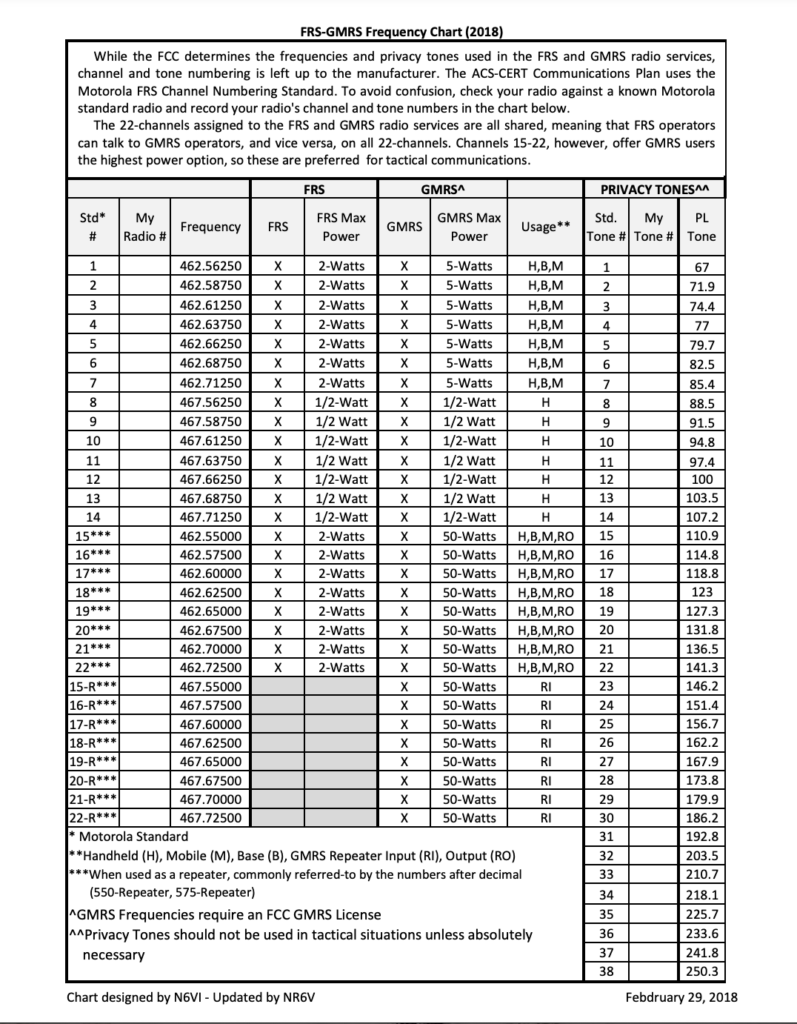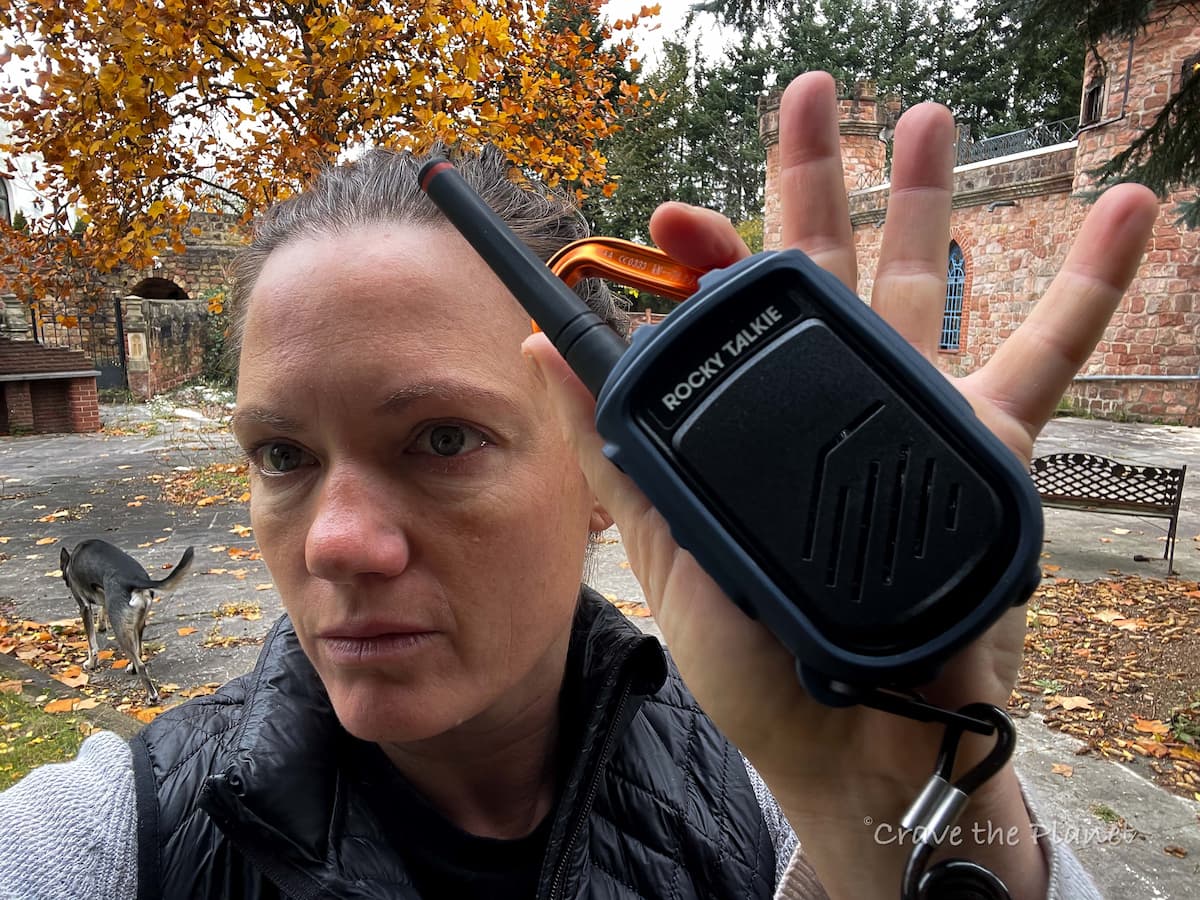Learn more with my GMRS radio frequency chart, but make sure you get a license first because with more power comes more responsibility.

👉 Read until the end to download a PDF version.
What You Will Learn
- Quick Verdict: General Mobile Radio Service (GMRS)
- GMRS Radio Frequency Chart
- Become a European Adventure Travel Insider in Just 5 minutes
- Full Table
- GMRS Direct Communication Channels and Output Power
- Newcomer on the Market: Rocky Talkie 5 Watt
- PDF Download
- Final Verdict: Best GMRS Radio for Outdoor Enthusiasts
- Common Queries on GMRS Radio Use
Quick Verdict: General Mobile Radio Service (GMRS)
General Overview:
- GMRS Band: UHF, typically for short-range communication
- License required from FCC for operation
- Power Output: Up to 50 watts for mobile, portable, and fixed stations
Key Points:
- 22 Channels available; some shared with FRS
- Utilize repeaters to extend range; repeater channels specific
- 5 watts max for handheld units with fixed antenna
- Multi-member household usage; immediate family
- Annual fee for licensing; exam not necessary
| Feature | GMRS | FRS |
|---|---|---|
| License | Required | Not needed |
| Power | Up to 50W | Up to 2W |
| Channels | 22 | 14 |
| Repeaters | Allowed | Not allowed |
| Antenna | External allowed | Fixed only |
| Bandwidth | 20 kHz | 12.5 kHz |
- Communication Needs: Suitable for individuals requiring reliable two-way voice communication with family or within groups over varied terrain.
- Equipment: Ranges from handheld to mobile radios; external antennas enhance range.
GMRS Radio Frequency Chart
Below is a detailed list of these channels, frequencies, and their respective technical specifications.
Summary
| Channel | Frequency (MHz) | Max Power | Bandwidth |
|---|---|---|---|
| 1 | 462.5625 | 5 W | 25 kHz |
| 2 | 462.5875 | 5 W | 25 kHz |
| 3 | 462.6125 | 5 W | 25 kHz |
| … | … | … | … |
| 14 | 467.7125 | 0.5 W | 12.5 kHz |
| … | … | … | … |
| 22 | 462.7250 | 50 W | 25 kHz |
Channels 1 through 7 and 15 through 22 permit a maximum power of 5 W and 50 W, respectively, and operate with a bandwidth of 25 kHz. Channels 8 through 14 are restricted to a lower power of 0.5 W and a narrower bandwidth of 12.5 kHz.
Moreover, GMRS offers repeater channels that allow for extended communication range by utilizing different frequencies for reception (RX) and transmission (TX). The maximum power output for repeater use is 50 W, with an authorized bandwidth of 20 kHz.
| Repeater Channel | RX Frequency (MHz) | TX Frequency (MHz) | Max Power | Bandwidth |
|---|---|---|---|---|
| RPT15 | 462.5500 | 467.5500 | 50 W | 25 kHz |
| … | … | … | … | … |
| RPT22 | 462.7250 | 467.7250 | 50 W | 25 kHz |
Please note that when using these frequencies, the authorized bandwidth is a vital aspect to adhere to for compliance with regulatory standards and how to use them. Ensure your equipment settings align with these specifications to maintain proper operation within the GMRS framework.
Become a European Adventure Travel Insider in Just 5 minutes
✨Unlock Europe’s best-kept secrets with our free bi-weekly newsletter.

Full Table

GMRS Direct Communication Channels and Output Power
Each channel is designated by a number and is associated with a specific frequency. The maximum allowable transmission power and the bandwidth for each channel also vary.
Newcomer on the Market: Rocky Talkie 5 Watt
- Transmission Range: Your 5-watt radio operates within the 462-467 MHz spectrum.
- Channel Allocation: It utilizes 22 established GMRS channels.
- Frequency Band: Communication takes place over the UHF band.
- Refer to the User Manual for detailed channel frequencies.
Final Verdict: Best GMRS Radio for Outdoor Enthusiasts
What we like: This GMRS 5 watt two-way radio is SUPER simple to use right out of the box and perfect for climbers, skiers and hikers that want security and good communications.
- Pros: 5 days battery life, 11 weather channels, -20F, NOAA alerts, Simplicity, 2-8 mile range, 2 year warranty, designed in Colorado
- Cons: Mic is extra, not cheap
Note: This high quality, yet mid-priced walkie talkie is our top pick for the Outdoor Adventure set but you will need an FCC license.
Common Queries on GMRS Radio Use
GMRS Channel Standardization and Frequencies
The General Mobile Radio Service (GMRS) is composed of 30 channels, with 22 primary channels shared with FRS services, and 8 additional repeater channels. Frequencies range from 462 MHz to 467 MHz. Channels 1 through 7 are shared with FRS and operate on frequencies between 462.5625 MHz and 462.7125 MHz, while the repeater channels (15-22) use frequencies from 462.550 MHz to 467.725 MHz.
| Channel | Frequency (MHz) |
|---|---|
| 1 | 462.5625 |
| 2 | 462.5875 |
| … | … |
| 22 | 462.7250 |
| *Note: Channels 8-14 are FRS only and not included here. |
Acquiring a GMRS License and Prerequisites
To legally operate a GMRS radio, you must acquire a license from the Federal Communications Commission (FCC). Applicants need to be 18 years or older, fill out the required FCC form, and pay the licensing fee. A single license covers immediate family members as well. No test is required, contrary to amateur radio licensing.
Repeater Channels and Their Operations in GMRS
GMRS repeater channels are specifically from 15 to 22. These channels have dedicated input and output frequencies, usually 467 MHz band frequencies paired with their corresponding 462 MHz band counterparts. Repeaters receive transmissions on one frequency and rebroadcast them on another to extend the communication range.
| Repeater Channel | Input Frequency (MHz) | Output Frequency (MHz) |
|---|---|---|
| 15 | 467.5500 | 462.5500 |
| … | … | … |
| 22 | 467.7250 | 462.7250 |
Permission and Restrictions for Unlicensed GMRS Use
GMRS channels 1-7 can be used without a license only if the radio operates at an output power of 2 watts or less. These are shared with FRS frequencies. However, channels 15-22 and the repeater channels are strictly licensed, and using them without FCC authorization can lead to fines.
Long-Distance Communication in the Trucking Industry
Channel 20, with the frequency of 462.675 MHz, is frequently used for long-distance communication among truckers. This is because it is a repeater channel, allowing for more extensive coverage and clear communication over longer distances.
Preferred Channel for Everyday GMRS Interactions
Channel 16 (462.575 MHz) is often chosen for general use due to its designation as a non-repeater channel, allowing for direct communication without the need for a repeater setup. It’s a good balance between accessibility and minimal interference from other users.

Hut to Hut Hiking in the Dolomites Free Course
Curious about hut-to-hut hiking in the Dolomites, but not sure where to start or what to expect? Sign up for our newsletter that simplifies and educates so you can focus on the views and vino. Get curious, get ready, and let’s get started! Sign up here👇🏼
- Free Email Course to Learn : Everything You Need to Know About Hut to Hut Hiking
I hope you enjoyed this explainer on the GMRS Radio Frequency Chart and Channels.

Author profile: Morgan Fielder is a Doctor of Physical Therapy and passionate hiker who believes in exploring the world on foot with good food. Follow her journey as she shares science-based hiking tips and advocates for sustainable tourism.

